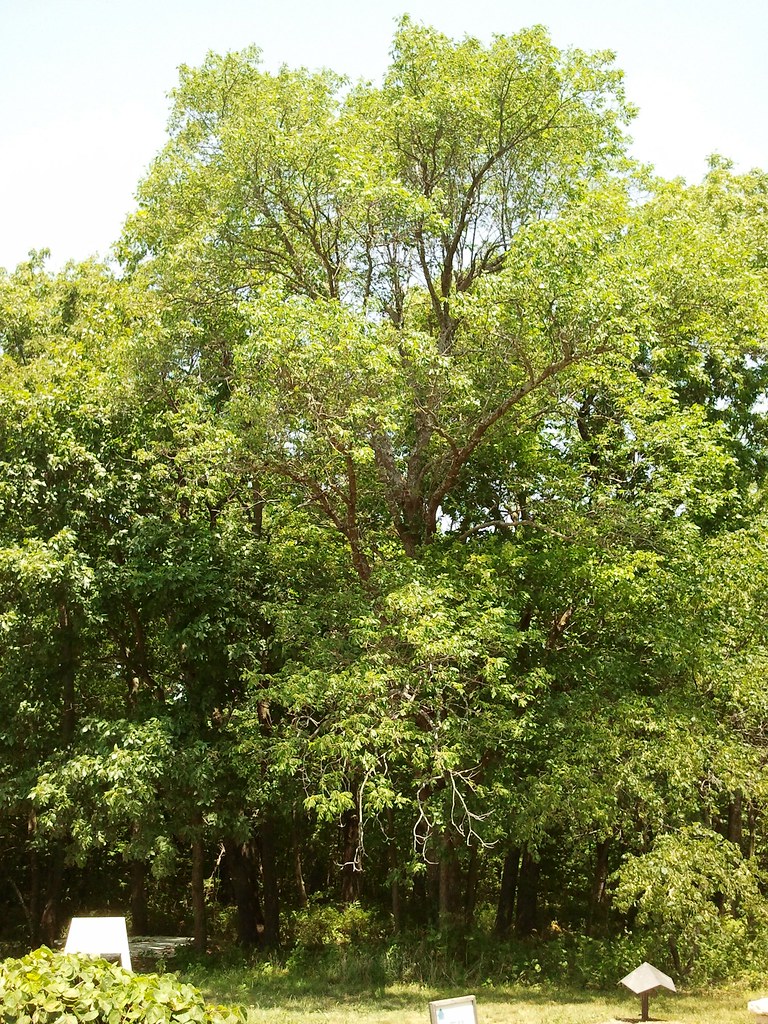We are now in the throws of a HEAT WAVE with temperatures flirting with 100F or more with a forecast for it to last at least a week. Heat waves near the summer solstice are especially brutal on us and plants because the days are so long. Trees have enormous value to us in times like this as their shade is the cheapest air conditioner available!
It is noticeably cooler in summertime when you enter this walk (and noticeably milder in winter too). But what is the real value of a tree during the year?


Last week Powell Gardens' Director, Eric Tschanz and I attended the American Public Garden Association's (APGA) national conference in Columbus, OH. I visited the Chadwick Arboretum on the Ohio State University Campus and was thrilled to see this sign that gave an actual dollar value of a shade tree! This particular Hackberry (Celtis occidentalis) was given a value of $265.09 per year. It's energy value in terms of cooling summertime and trapping a bit of warmth in the winter was given as over $80 per year of that value. I was disappointed no value was given to it hosting 5 species of butterflies and providing fruit for winter birds -- many things just can't be assigned dollar values!
Here's an image of a tree that helped inspire Powell Gardens. We call it Marjory's Oak and it stands in front of the Chapel. It's a maturing Shingle Oak (Quercus imbricaria) and it survived the catastrophic ice storm of 2002. The image was taken from INSIDE the chapel today. The late Marjory Powell Allen was a leading human force that helped create Powell Gardens and her spirit is still present here as she inspired many and left a lasting legacy. As most trees live for many human generations they leave a lasting legacy of the past that is impossible to assign a value.

This young oak also has significance at Powell Gardens as it was planted on Arbor Day 1990 to honor Chuck Brasher, local tree expert and friend of Marjory. We are sad to announce that Chuck passed away Tuesday at age 90 and his knowledge of trees and his charity and altruism will be greatly missed. This Swamp White Oak (Quercus bicolor) graces the old (deliveries and staff) entrance to Powell Gardens and is a constant reminder of Chuck and his love for and expertise with trees. He maintained the list of Champion Trees of Greater Kansas City and I had the pleasure of spending many days with him measuring and scouting for champion trees. Chuck wrote a list of the value of trees along with the champions:
Think Trees... Your future depends on their survival!
*TREES supply the oxygen we need to breathe.
*TREES keep our air supply fresh by absorbing carbon dioxide that we exhale and also that which we emmitted by factories and engines.
*TREES are natural air conditioners. They lower air temperatures by evaporating water in their leaves.
*TREES cut down on noise pollution by acting as sound barriers.
*TREES trap and filter out dust and pollen on their hairy leaf surfaces.
*TREES shelter us from direct sunlight on hot sunny days.
*TREES roots stabilize the soil and prevent erosion.
*TREES camouflage unsightly scenes and break the monotony of endless highways, sidwalks and lawns.
*TREES slow down strong winds.
*TREES give us privacy.
And lastly Chuck included: A country without children would be hopeless... a country without trees would be almost as hopeless!
Trees leave a lasting legacy to the future as well -- a Swamp White Oak can easily live 300 years or older.
See Champion Trees of Greater Kansas City at http://www.countryclubtreeservice.com/.

This large shade tree is a White Ash (Fraxinus americana) in front of the Chapel. White Ash are threatened by an imported exotic pest, the Emerald Ash Borer (EAB) which is ravaging ash trees in the eastern Midwest and is spreading our way. I learned at our APGA conference last week that with treatment as EAB arrives and for several years thereafter, your ash trees can be saved and their appreciating value retained. Good News as I thought there was no hope for ash trees and the over 400 species of insects and other creatures besides ourselves who need them for their livlihood. Powell Gardens will be spreading the word of what local communities and landowners should do as part of The Sentinel Plant Network that APGA and the United States Department of Agriculture have set up to monitor and advise about threatening pests and diseases.

Just remember from tiny acorns mighty oak trees grow. This is one of our seedling sof the extirpated (locally extinct) Arkansas population of Bigleaf Magnolia (Magnolia macrophylla). Powell Gardens was given 5 seedlings of these important trees by Dick Figlar as part of our North American Plant Collection Consortium Magnolia collection where part of Powell Gardens' responsibility is to preserve and protect the native magnolias found west of the Mississippi in Missouri, Arkansas and Oklahoma. These magnolias were once found on Crowley's Ridge just 8 miles south of the Missouri border and their importance is that as the western most population by many, many miles; they probably offer improved drought resistance. Bigleaf magnolia has the largest leaf of any North American tree and takes about 15 years to bloom. Some day this tree will really inspire visitors with its 3 foot leaves and 12 inch fragrant blossoms! How does one assign a value to the beauty of trees? I hope you all are inspired to visit Powell Gardens and its extensive collection of trees and to plant a tree yourself for their appreciating dollar value AND for their value beyond human currency designations.




No comments:
Post a Comment